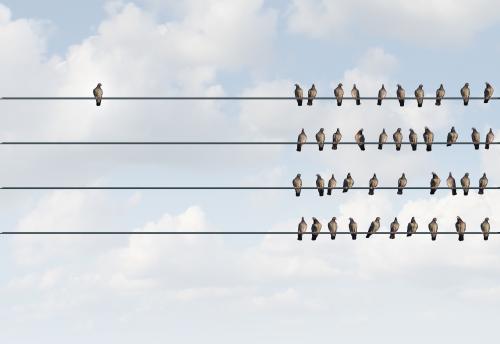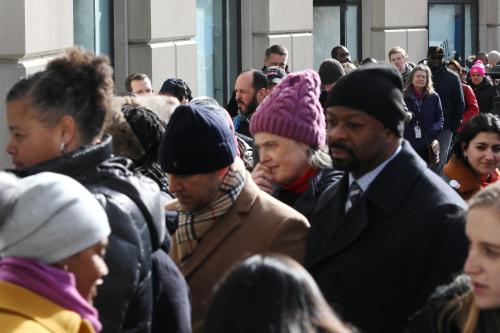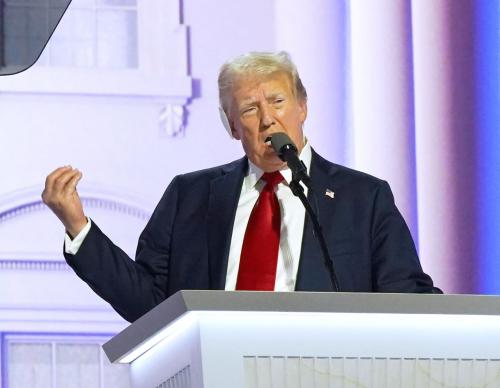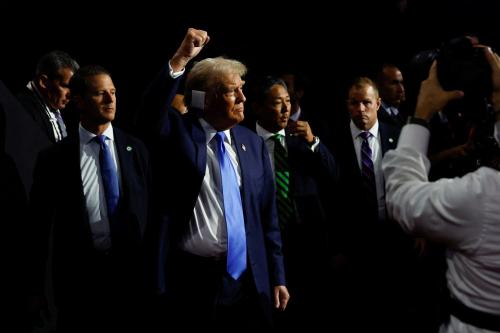In the wake of a tempestuous national election, it is very clear to most observers that the U.S. body politic is in a state of some disarray. Our politics seem more polarized than at any time in the past century or earlier, with many voters and political leaders (including Donald Trump and his supporters) refusing to even acknowledge the apparent election of Joe Biden to the presidency. Anger not only over the COVID-19 pandemic but over economic and racial inequality have led many thousands of protestors into the streets in recent months and to occasional clashes between activists of the left and the (sometimes armed) right. Though the widespread fear of civil unrest after the elections has so far proven unfounded, risks remain.
But has America been there before, and come through it fine? At other points of U.S. history, have the conflicts associated with inequality and polarization not only been resolved, but resulted in more cohesion and widely shared prosperity?
This is the thesis of a new book called The Upswing by Robert Putnam and Shaylyn Romney Garrett. They present evidence that our current levels of economic and political polarization are not greatly different than they were in the 1890s, at the peak of the “Gilded Age.”
But the Gilded Age was soon followed by the beginning of the Progressive Era, which many historians associate with the ascendancy of Teddy Roosevelt to the presidency in 1901 (after President William McKinley was assassinated). This era of relatively egalitarian economic and political reform continued through the presidencies of William Howard Taft and Woodrow Wilson until the 1920s. And, with the coming of the Great Depression and the New Deal in the 1930s, as well as the civil rights legislation and War on Poverty in the 1960s, the egalitarian drift in American politics continued.
Will history repeat itself? In other words, is another Progressive Era coming now?
The thesis of The Upswing
The argument put forward by Putnam and Garrett goes well beyond the historical observations above and builds on them in a number of important ways.
First, they argue that the Gilded Age and our current era are similar among several dimensions – economic, political, social, and cultural. Putnam and Garrett present evidence that, like now, the U.S. of the Gilded Age was characterized by dramatic increases in economic inequality, political polarization, a low level of social and communitarian cohesion, and a culture that celebrated the nearly unfettered rights of the individual to whatever economic and political gains they could attain. Celebrations of the great wealth of the industrialists of the time and a growing acceptance of “Social Darwinism” as a governing philosophy were widespread.
But, second, Putnam and Garrett argue that much of this began to change with the beginning of the Progressive Era after 1900. For nearly 70 years, they show an increase in economic equality (often referred to by economic historians as “The Great Compression”), political reforms that increased democratic participation, a rise in public participation in social institutions (including civic associations and trade unions) and a culture that became more communitarian and less individualistic.
The mechanisms through which these changes occurred were varied. Rising economic equality was generated by the establishment of universal high school education, the rise of trade union membership, financial market reforms (including the creation of the Federal Reserve system), and progressive taxes and public spending. Political reforms included the direct elections of U.S. senators and expanding suffrage for women and later African Americans. They also show a rise in bipartisan activity in Congress and in political consensus in polling data. Social institutions in which participation rose included a range of civic organizations and trade unions. And cultural shifts reflecting a growing emphasis on family and community during that time are found in everything from polling data to text analyses of journalism and other publications. The growth of equal rights for both women and African Americans (as well as other minorities) are separately and similarly documented, with evidence that both groups made important strides over the entire 20th century before the more dramatic changes of the 1960s.
Third, Putnam and Garrett show that, starting in the 1970s, these trends began to reverse themselves. They document rising economic inequality, rising political partisanship and polarization, declining participation in civic institutions and a general rise in emphasis on individual rights rather than social responsibility. They note at best some flattening and even reversal of economic progress for minorities (especially African Americans), particularly associated with mass incarceration; such reversals are much less true for women, though their progress in labor force activity (and in obtaining crucial support for child care and paid family leave) have stalled.
Indeed, they show that the current era bears remarkable resemblance to the Gilded Age on all four dimensions. They characterize the pattern on all four dimensions of the past 120 years as reflecting an “I-we-I” cycle, and their evidence is compelling.
Of course, the most important implication of this analysis is that the U.S. might well be on the cusp of another “upswing” in egalitarian economic policy, political consensus, communitarian activity and emphasis on the collective good. Putnam and Garrett highlight the forces that they believe drove the beginning of the Progressive Era (besides the ascendancy of Teddy Roosevelt to the White House), including the work of “muckraking” journalists (like Ida Wells) and crusades by social reformers like Frances Perkins (who became Secretary of Labor in the New Deal era) and Jane Addams (of the “settlement house” movement for immigrants).
Putnam and Garrett argue that at least some of these reformist instincts are now becoming visible once again, especially among Millennials and the youth of Generation Z. Just as moderates of the Progressive era were goaded into action by the growing numbers of socialists and populists then, the activism of the “Black Lives Matter” and environmental movements (and even some sympathy of the young for socialism) might prod more moderate progressives today to find common cause with them and build a broader movement.
The Upswing gets a lot right
Putnam and Garrett have generated a very impressive analysis of broad trends in the U.S. over a period of 120 years. The fact that economic, political, social and cultural patterns are so similar over this time period is both new and very striking. Not every pattern looks exactly the same – more rapid improvements in racial or gender equality, for instance, characterize some periods (like the 1940s and 1960s) while more economic “compression” is observed in the 1930s. All progress does not end in 1970, though many shifts begin to occur during that decade (especially in response to the turmoil of the 1960s) and accelerate under the presidency of Ronald Reagan in the 1980s.
Putnam and Garrett are commendably cautious in attributing causality to any particular factor in generating the swings they observe. They point out, for instance, that more egalitarian economic and social changes seem to precede political reform and bipartisanship. They are also careful in analyzing exactly what led to the great “upswing” of progressive activity after 1900 and in drawing parallels to our current time.
But there are differences between then and now
There are, of course, limits to the commonality of the broad patterns we see. For instance, the Great Depression was the catalyst for the New Deal legislation that established the right of workers to bargain collectively, the first federal wage and hours regulation, and social insurance programs like Social Security.
World War II also generated a somewhat unique period of social cohesion and common purpose after the U.S. was attacked by Japan at Pearl Harbor and as the national interest in defeating the Axis nations was reinforced by the widely perceived moral necessity of doing so. It is unclear that anything similar to those unifying events will occur again – nor do we want them to.
Interestingly, the social cohesion the U.S. experienced after the 9/11 attacks in 2001 didn’t even last until the arrival of the election season in 2002, when President Bush and a number of Republicans attacked Democratic rivals as being weak on national defense and on securing the country against potential terrorist threats. The launching of the Iraq War in 2003, and the subsequent insurgency that American troops faced there, generated a strongly partisan counterattack by Democrats in the 2006 and 2008 elections.
Of course, the collapse of the housing and financial markets soon led to the Great Recession, and a number of other forces (like the bailouts of banks, a flood Chinese imports that eliminated millions of manufacturing jobs, rising immigration and even having an African-American president) created a right-wing populist backlash and the Trump presidency. And somewhat similar political developments in Europe and even Asia indicate that broad anger over trade, immigration, and rising diversity are not unique to the U.S.
Around the industrial world, it is hard to see much sign yet of an “upswing” in support of economic or political reforms that would be more egalitarian and communitarian in nature (notwithstanding the results of the 2020 election in the U.S., which produced few clear wins for Democrats and progressives outside of the presidency).
A few more reasons for caution
In addition, I find some other differences between the beginning of the Progressive Era and the one in which we currently live in the U.S. that lead me to be a bit more cautious in my optimism about an imminent rebound in economic egalitarianism and political bipartisanship right now.
In particular, these factors are:
- The current wedge between the attitudes of working-class whites and progressives (who are mostly highly educated whites and minorities more broadly), especially over race; and
- The federal fiscal crunch that grows with almost each passing year.
The realignment of American politics since the 1960s has been quite dramatic. Large groups of Democrats – especially the South, white ethnics and working-class whites – left the party and its progressive politics to support Republicans, and most recently the nativism of Donald Trump. They were replaced as Democrats by highly-educated white progressives and growing minority populations, most of whom are concentrated geographically in large metro areas and especially the coasts of the U.S.
Indeed, the political chasm between these groups has grown wider in the Trump era. At the same time, the smaller towns and rural areas that constitute the backbone of Trump support have disproportionate political power, as lightly populated states have large numbers of U.S. senators and electoral votes. Within states, partisan gerrymandering since 2010 has reinforced this power.
I see little sign that the “red” states will have any interest in relinquishing the disproportionate power they wield, or in joining political or economic forces with those in “blue” states. A number of analyses in recent years indicate enormous gulfs in the outlooks of those in “blue” and “red” regions, with little sign of their abatement.[1]
And much (though surely not all) of this realignment can be attributed to one contentious issue: the role of race in American life. Indeed, Putnam and Garrett devote an important chapter of their book to the growing egalitarianism over race through the 1960s and the development of a growing white “backlash” in the late 1960s and beyond that fueled Republican and conservative political success. Today, nativist reactions to immigration reflect some of the same views.
Putnam and Garrett attribute the backlash to white resentments over the loss of their “privilege” and the weakening of their relative economic power and status. They correctly note white anger over the urban upheavals of the 1960s (which the authors consider to have been an understandable explosion of black anger and frustration after centuries of domination by whites), as well as policies like Affirmative Action (which they consider necessary to offset the legacies of white racism and ongoing systemic disadvantages facing African Americans – and with which I agree). There is no doubt a good deal of truth in these characterizations.
But I also feel that Putnam and Garrett somewhat misunderstand and mischaracterize the white backlash that began in the late 1960s. Whether we agree or not, the white ethnic and working-class voters who abandoned the Democratic party in the 1970s and beyond had a range of motivations. They were angry over large increases in violent crime, what they perceived as “reverse discrimination” in Affirmative Action, and a set of income transfer policies (especially Aid to Families with Dependent Children, or AFDC) that reduced work among low-income women. To characterize these white and (often working and middle-class voters) only as sore losers of “white privilege” is not accurate in my view – especially in light of the devastation of white working-class communities that has been documented by Case and Deaton (2019), among others.
In light of this view, can anyone rebuild a coalition of racial minorities, progressives, and at least some members of the white working and middle classes? Perhaps. One might argue that the “wedge” issues of crime and welfare are diminishing in salience with time. Thankfully, violent crime has declined greatly in the past 25 years (though there have been signs of recent increases); AFDC was eliminated and replaced by Temporary Assistance to Needy Families (TANF) in the 1990s, which reduced work disincentives (as well as cash support for the poor more generally). While spending on antipoverty programs has risen recently in the form of Medicaid, food stamps, and the Earned Income Tax Credit, these programs show little evidence of discouraging employment as did AFDC.
It is also possible that the U.S. Supreme Court, with its new conservative majority of six justices, will eliminate Affirmative Action in the coming years, at least as we have known it. As a supporter of Affirmative Action, I would not at all welcome this development; as Cornel West famously said, “race matters.” But a winding down of Affirmative Action might reduce white resentment along one more dimension. It could perhaps lead to admissions practices in universities that place more emphasis on shared economic disadvantage than racial disadvantage, which more working- and middle-class whites could support.
Indeed, the Biden campaign of 2020 tried to develop an agenda that appeals to working-class whites as well as racial minorities – one that acknowledges ongoing and troubling racial disparities in all walks of life, while also trying to address the economic stagnation and deterioration suffered by working and middle-class Americans while the rich grow ever wealthier.
Whether they can successfully do so, and whether this is the beginning of a new period of progressive economics and politics, remain to be seen. But the likely hold on the U.S. Senate by Republicans (unless Democrats can win both Georgia senate races in the upcoming runoff elections), and the closeness of the results between Trump and Biden, suggest that conservatives will have little incentive to do things differently anytime soon.
And there is one more major hurdle that could also limit the development of a new progressive majority: the discouraging fiscal situation in which the federal government finds itself.
The ratio of public debt to GDP in the U.S. has risen dramatically in the past two decades as a result of both growing spending and regressive tax cuts. The fiscal stimulus in response to the Great Recession and the pandemic-driven economic shutdown in 2020 have contributed to the debt, as has the tax cut of 2017 and its earlier incarnations. (I am vastly more sympathetic to the former than the latter.)
And the ongoing gaps between projected expenditures, especially on retirement programs, and our projected revenues continue to grow. The “no tax pledge” that approximately 90 percent of Republican House members and Senators have signed (under pressure from anti-tax activist Grover Norquist) renders it impossible to address these imbalances in the near future in a bipartisan manner.
Of course, it is not impossible to fund progressive priorities while reducing our long-term debt; my Brookings colleague William Gale (2019), among other economists, has recently outlined how to do so. Given the damage created by both the current economic slowdown and the long-term trends hurting the U.S. working and middle classes, I fully share the view that our most immediate top priority must be improving equity and restoring widely shared economic growth (in an environmentally sound manner), rather than fiscal retrenchment.
But the inherent conflicts between trying to enact another (and “greener”) New Deal on the one hand and addressing our long-term debt on the other remain daunting, especially given the anti-tax straitjacket imposed on itself by one of our two major political parties. Indeed, it is impossible to generate newly progressive policies without major and lasting increases in tax revenues, hopefully achieved in a progressive manner. But, rightly or wrongly, the Republican party shows nearly zero interest right now in any such policy shifts.
Absent a major political upheaval, and a painful reckoning of the Republican party with both its Trumpian (and earlier) nativism and its economic regressivity, it is hard for me to fully share the optimism of Putnam and Garrett. Still, we should try; and their new book is highly enlightening and gives us at least some hope for the future as well.
[1] See, for instance, Frank (2004), Vance (2016), and Hochschild (2016).





Commentary
Op-edIs another Progressive Era coming?
Thoughts on 'The Upswing' by Putnam and Garrett
November 10, 2020